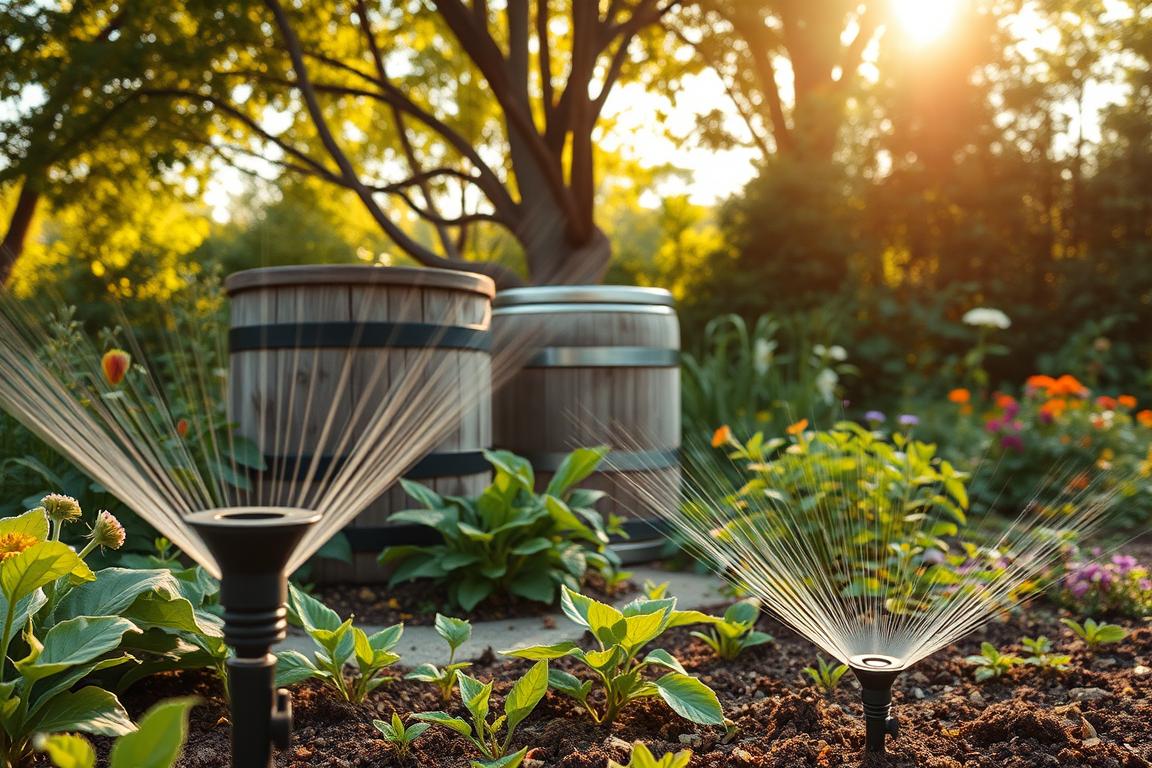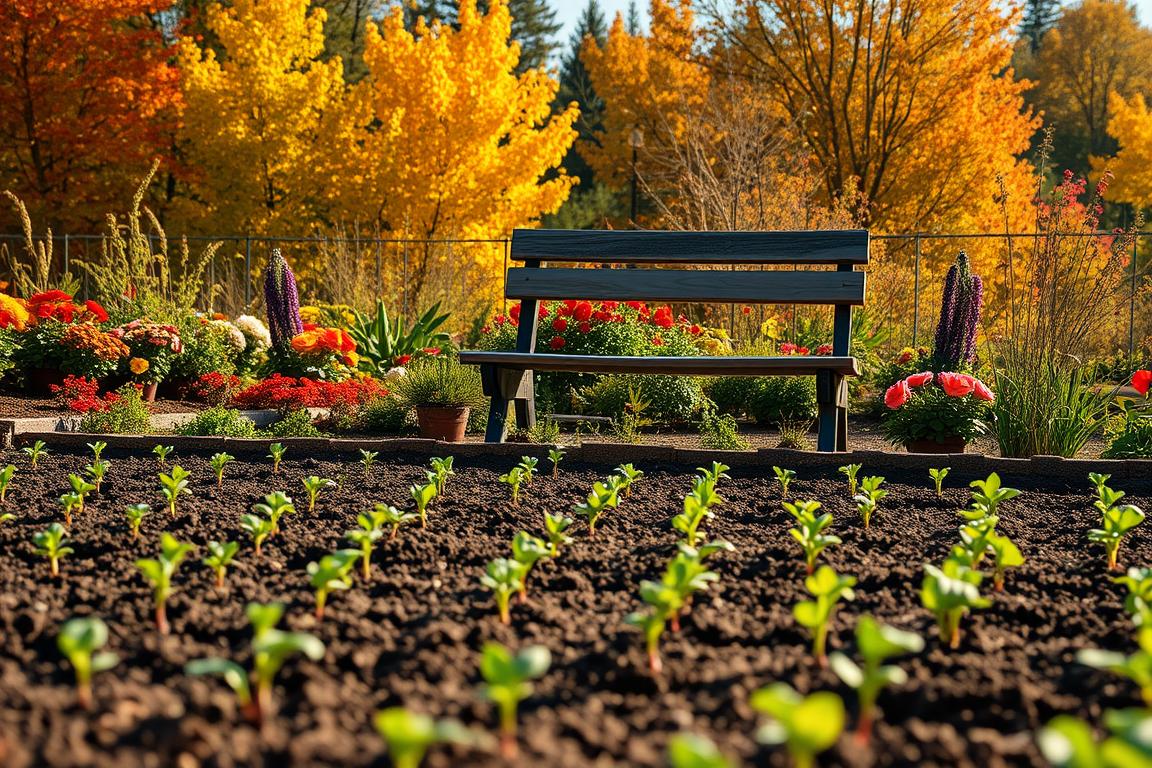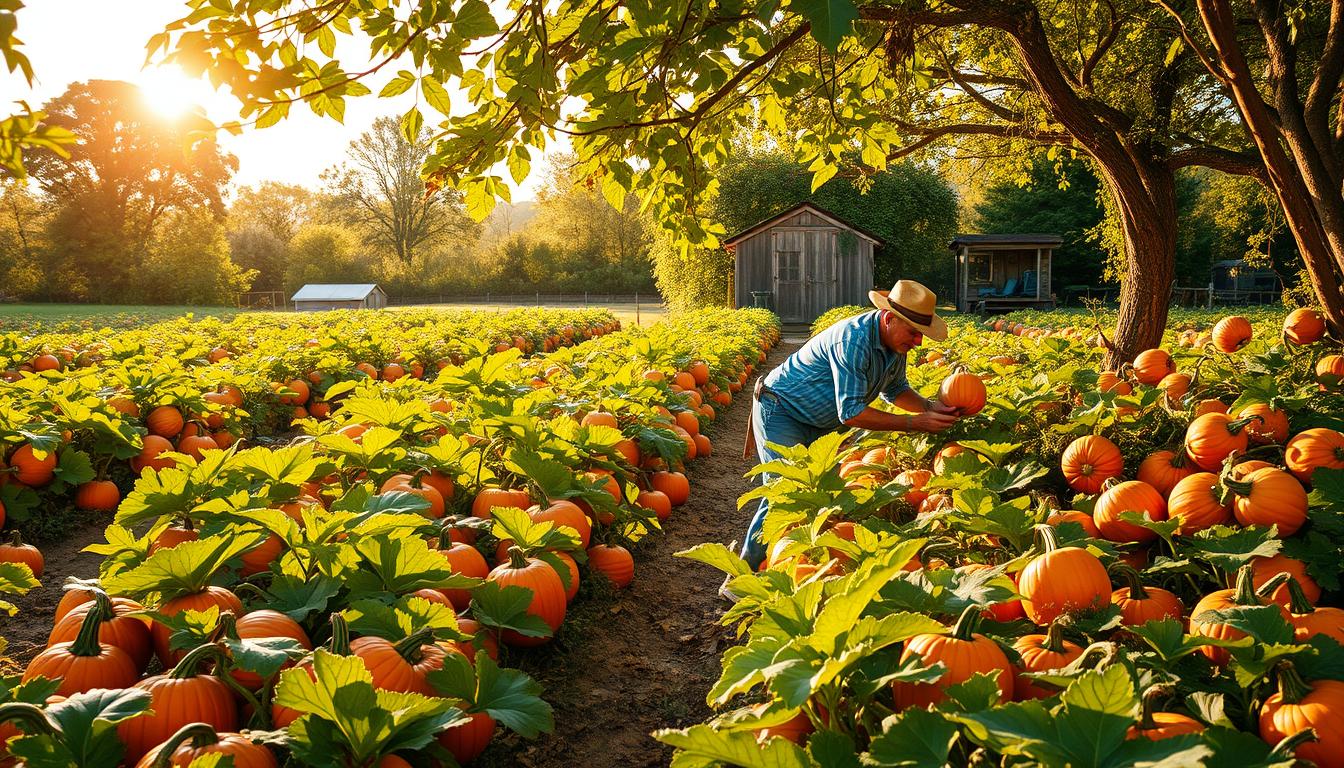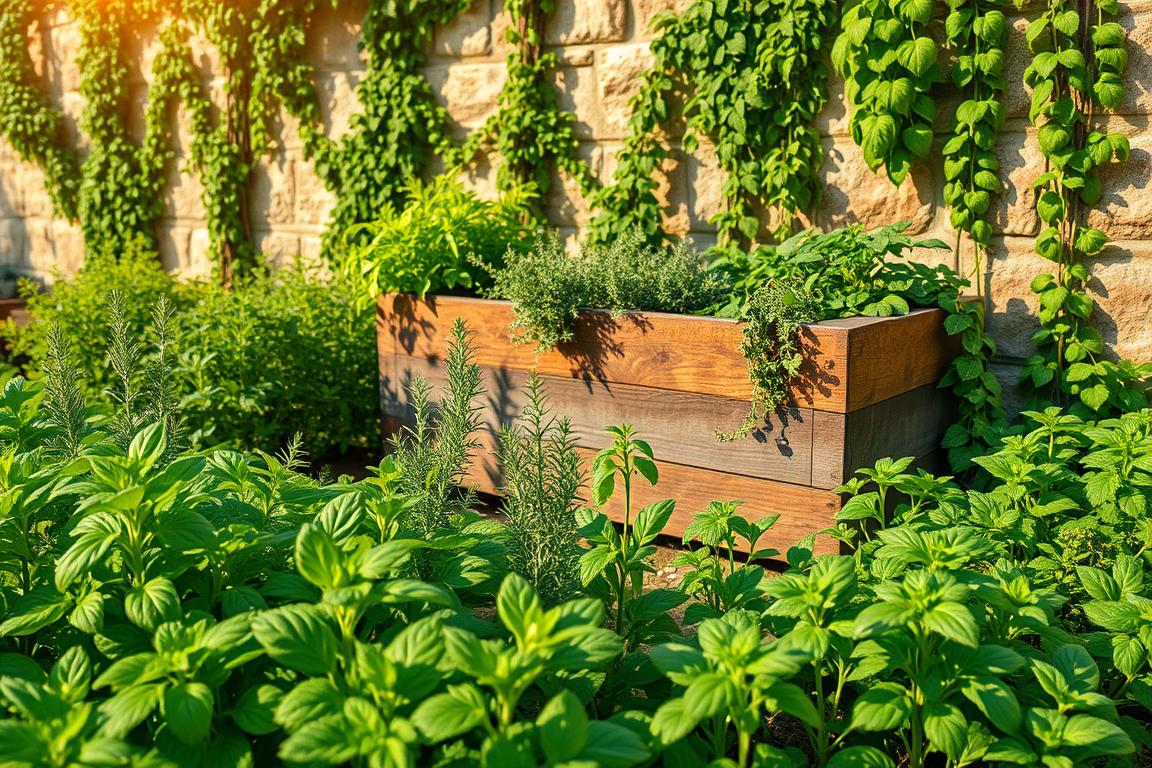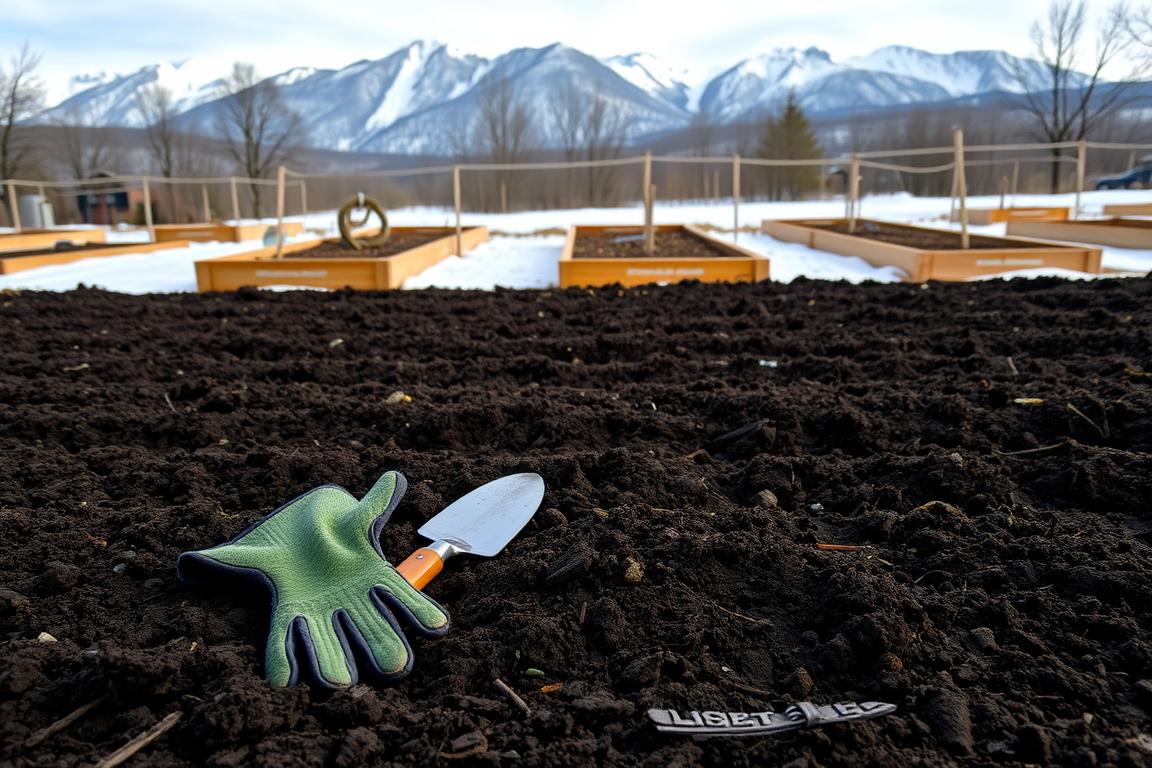We’re all trying to lessen our harm to the planet. Eco-friendly watering solutions are key. Using water conservation products is a big step.
Collecting rainwater from our roofs saves money and helps the planet. Rain barrels make watering our gardens easier.
Using smart irrigation with rainwater saves even more. It’s a win-win for our gardens and our wallets. These eco-watering solutions help us care for the environment and cut down on water costs.
The Water Conservation Crisis: Why Eco-Watering Matters
We’re facing a big water crisis, and we need to find ways to save water. The average home uses almost 100 gallons of water every day for watering plants. But, a lot of this water is wasted because of old, bad ways of watering.
Current Water Usage Statistics in American Gardens
Water use in American gardens is a big problem. Almost 30% of all water used at home goes to watering plants outside. This means billions of gallons of water are used just for watering plants.
| Category | Water Usage |
|---|---|
| Average Household | 100 gallons/day |
| Outdoor Water Use | 30% of total |
Environmental and Financial Impact of Traditional Irrigation
Old ways of watering waste water and hurt the environment and our wallets. They can cause water to run off, soil to erode, and use more energy. Plus, wasting water means higher water bills for us.
“Conserving water is crucial for a sustainable future. Implementing eco-watering solutions is a step in the right direction.”
Using eco-watering like rain barrels and smart irrigation can really help. It can cut down our water use and help our planet.
Understanding Rain Barrels and Smart Irrigation: Eco-Watering Solutions
Exploring eco-watering solutions means looking at rain barrels and smart irrigation. These technologies work together to make watering our gardens and landscapes efficient.
What Are Rain Barrels and How Do They Work?
Rain barrels collect and store rainwater from our roofs. This water is then used for irrigation. This rainwater harvesting system helps us use less municipal water. It also lowers our water bills and reduces the strain on water treatment facilities.
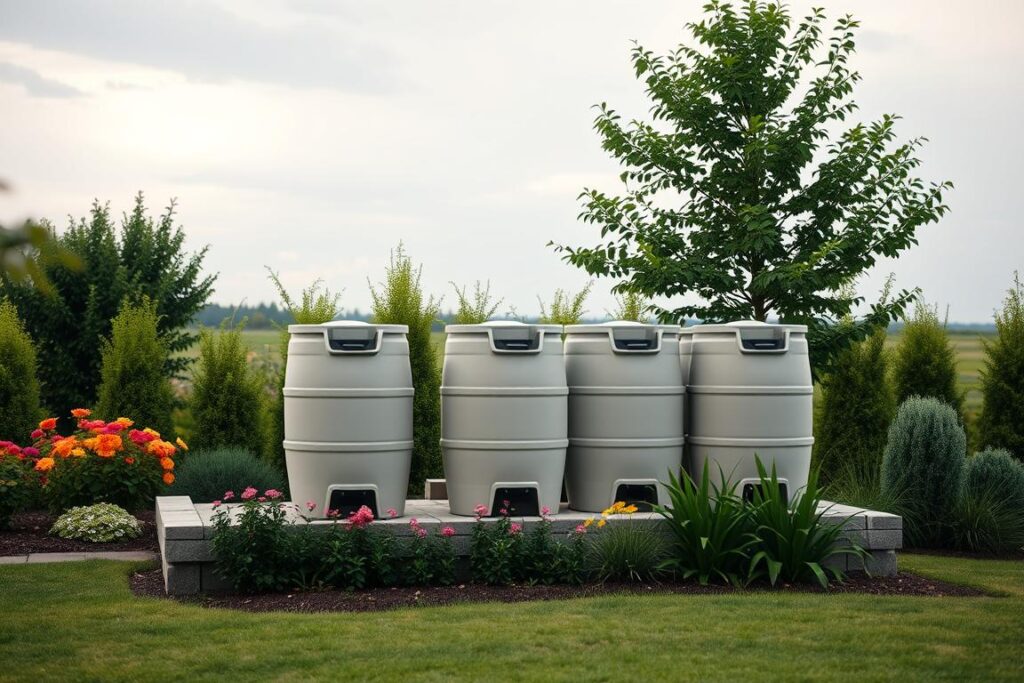
Smart Irrigation Technologies Explained
Smart irrigation technology uses controllers and sensors. It adjusts watering schedules based on weather, soil moisture, and plant needs. This ensures our gardens get the right water at the right time, cutting down on waste and runoff.
Benefits of Combining Both Approaches
Using rain barrels with smart irrigation creates an eco-conscious landscaping approach. This combo maximizes water efficiency. It allows us to water our gardens well while being kind to the environment. Together, these technologies make gardening more sustainable.
How to Select the Right Rain Barrel for Your Property
To get the most out of rainwater harvesting, picking the right rain barrel is key. There are many rainwater harvesting products out there. This can make choosing one hard.
Types and Sizes of Rain Barrels Available
Rain barrels come in all sizes, from 50 gallons to 500 gallons. The size you pick depends on your roof’s size, how much rain you get, and how you plan to use the water.
| Rain Barrel Size (Gallons) | Ideal Roof Catchment Area (sq. ft.) | Average Rainfall (inches) |
|---|---|---|
| 50 | 200-400 | Low |
| 100 | 400-800 | Moderate |
| 500 | 1500-3000 | High |
Material and Durability Considerations
Rain barrels are made from plastic, wood, and metal. Think about how long it will last and how easy it is to keep clean.
“A good rain barrel can last for many years if properly maintained.”
Aesthetic Options for Different Landscapes
The look of a rain barrel can make your garden better or worse. Pick one that fits your garden’s style.
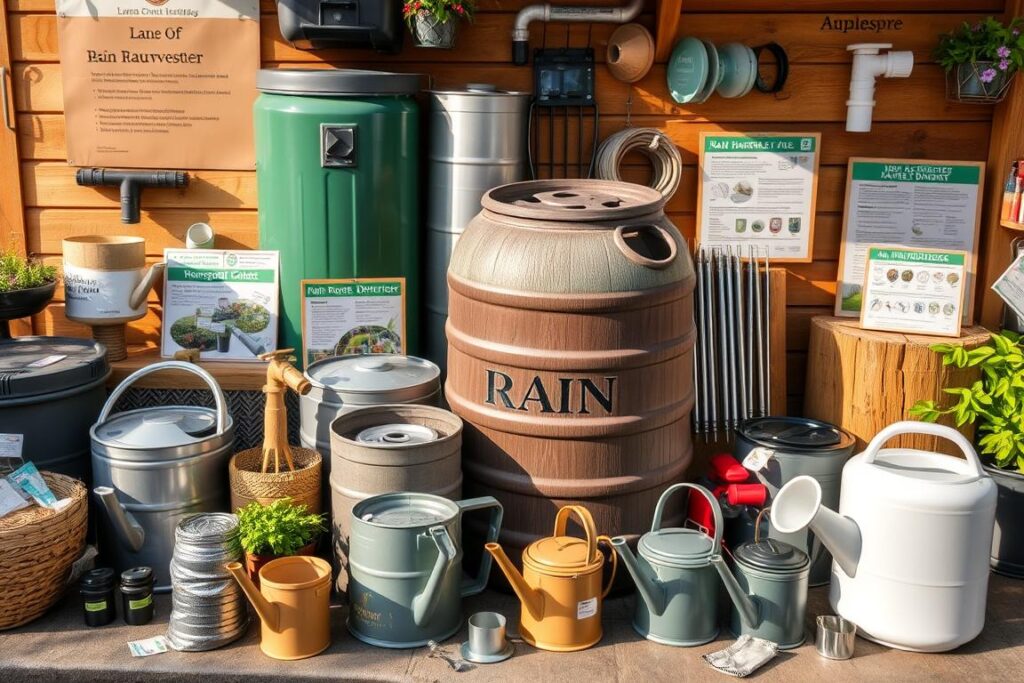
Budget Considerations and Return on Investment
The cost of a rain barrel is important, but think about the long-term savings too. A rain barrel can save you money on your water bill over time.
Step-by-Step Guide to Installing Your Rain Barrel System
To start harvesting rainwater, follow our guide on setting up your rain barrel system. This guide covers key steps to create an efficient eco-friendly watering system.
Tools and Materials You'll Need
First, gather the tools and materials you need. You’ll need a rain barrel, a diverter or first flush device, Teflon tape, a hacksaw or pipe cutter, and mosquito netting or a screened cover. Make sure your rain barrel fits your gutter system and is the right size for your property.
Preparing Your Downspout Area
Start by preparing the downspout area for your rain barrel. Clear any debris and make sure the area is level. If needed, use blocks or a stand to elevate the barrel for easier filling or hose connection.
Setting Up a Stable Platform
A stable platform is key for your rain barrel system’s longevity. Choose a level surface or create a base that won’t shift. This step prevents damage to your barrel and ensures it works right.
Connecting to Your Gutter System
To connect your rain barrel to the gutter system, modify the downspout. Cut it a few inches above the bottom and attach a diverter or elbow to direct water into the barrel. Use Teflon tape to secure any threaded connections.
Installing Overflow Protection
Overflow protection is crucial to prevent water from gathering around your foundation. Install an overflow valve or pipe to direct excess water away from your home. This step keeps your rainwater harvesting solution intact.
Testing Your System
After installation, test your rain barrel system. Simulate rainfall or wait for the next rain. Check for leaks, ensure the overflow works, and make any needed adjustments.
| Step | Description | Tips |
|---|---|---|
| 1 | Gather Tools and Materials | Ensure compatibility with your gutter system |
| 2 | Prepare Downspout Area | Clear debris and ensure the area is level |
| 3 | Set Up a Stable Platform | Use a level surface or create a stable base |
| 4 | Connect to Gutter System | Use Teflon tape for secure connections |
| 5 | Install Overflow Protection | Direct excess water away from your home |
| 6 | Test Your System | Check for leaks and ensure proper overflow function |
By following these steps, you can create an effective automated watering system that uses rainwater harvesting. This contributes to a more sustainable gardening practice.
How to Implement Smart Irrigation in Your Garden
Smart irrigation is more than saving water. It’s about making gardening more efficient. With technology, we can tailor watering to our garden’s needs. This saves water and helps plants grow better.
Choosing the Right Smart Controller
Choosing the right controller is the first step. This device controls when and how much water your garden gets. Look for one that’s easy to use and has features like customizable schedules and weather adjustments.
Installing Soil Moisture Sensors
Soil moisture sensors are key for smart irrigation. They show how wet or dry the soil is. With these sensors, we can water our plants just right, avoiding too little or too much water.
Setting Up Weather-Based Systems
Weather-based irrigation systems adjust watering based on the weather. They use local forecasts to skip watering on rainy days and water more on hot, dry days. This is a big step towards greener gardening.
Implementing Drip Irrigation Components
Drip irrigation sends water straight to the roots, cutting down on evaporation and runoff. Adding drip irrigation to our system helps save water and water more efficiently.
Integrating with Home Automation Systems
We can also link our irrigation system to our home automation. This lets us control and check our irrigation from anywhere. It’s a smart way to keep our garden healthy.
By following these steps, we can make our gardening more sustainable and efficient. We’ll save water and help our plants thrive.
Maintenance and Troubleshooting Your Eco-Watering System
To keep your eco-watering system working well, you need to do a few important things. These tasks help it run at its best and save more water.
Seasonal Maintenance for Rain Barrels
It’s important to clean and check your rain barrels for leaks regularly. Doing this can make your rain barrel last longer and work better.
Winterizing Your System
Before winter, you should winterize your eco-watering system. This means draining the rain barrel and taking it off the downspout. This stops it from getting damaged by cold weather.
Common Problems and Solutions
Some common problems with eco-watering systems are clogged filters and broken sensors. Checking your system often and fixing problems quickly can stop bigger problems later.
Upgrading Your System Over Time
As new technology comes out, you might want to upgrade your eco-watering system. Adding new features like better soil moisture sensors or more efficient irrigation controllers can make your system even better.
Measuring and Tracking Water Savings
It’s important to track how much water your system saves. You can do this by watching your water bills and using data from your smart irrigation controller.
| Maintenance Task | Frequency | Benefits |
|---|---|---|
| Clean Rain Barrel | Quarterly | Prevents Clogging |
| Check for Leaks | Bi-Annually | Conserves Water |
| Update Smart Controller Software | Annually | Ensures Optimal Performance |
By following these tips, you can keep your eco-watering system running smoothly. It will continue to help you garden in a way that’s good for the planet.
Conclusion: Embracing Sustainable Watering for a Greener Future
Adopting green gardening solutions can greatly reduce our environmental impact. Using rain barrels and smart irrigation systems helps save water and cuts down on water bills. This approach not only saves money but also helps our planet.
Starting our journey to sustainable water usage is easy. Rain barrels let us collect rainwater, reducing our need for city water. Smart irrigation systems help us water more efficiently. Together, they make our gardens water-friendly and good for the environment.
It’s crucial to understand the role of sustainable water usage in our lives. Making smart choices about watering helps us build a greener future. We can make our world more sustainable, garden by garden, with these eco-friendly watering solutions.


